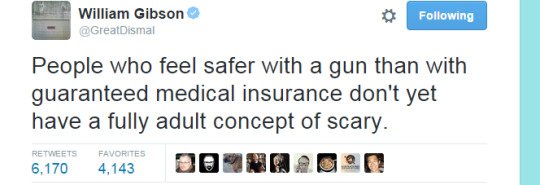Photo

Nnedi Okorafor Is Putting Africans at the Center of Science Fiction and Fantasy
“In postapocalyptic and apocalyptic narratives when they show the whole world freaking out about something that is happening to the Earth, they never show Africa,” says Nnedi Okorafor, the author of 11 books of science fiction and fantasy, among them the award-winning Zahra the Windseeker, The Book of Phoenix and Who Fears Death. “I wasn’t seeing it, so I started writing it.”
Okorafor is talking about science fiction-fantasy writing, a genre that, within a publishing industry known for its lack of diversity, is especially lacking people of color. Indeed, a recent spate of examples gives credence to this: the outcry against casting a black Stormtrooper in Star Wars; the outcry, again, over the casting of a black Hermione Granger in the new play Harry Potter and the Cursed Child; and the outcry against the black character Rue in The Hunger Games. “I was pumped about The Hunger Games,” said Twitter user John Knox IV. “Until I learned a black girl was playing Rue.” And on and on and on.
This resistance to the portrayal of black characters makes no sense. The entirety of the science fiction-fantasy genre is based upon the overarching experience of the global African Diaspora. Enslaved peoples, colonization and genocide—with the women of the oppressed group at specific risk for being targets of sexual violence—are the usual narratives of the sci-fi-fantasy genre. These are all experiences that people of the global African diaspora have lived—and live—every day. So why is it that the public imagination has such a hard time envisioning people of color in science fiction and fantasy worlds?
The Root sat down with Okorafor to discuss the lack of people of color in science fiction and fantasy, how Nigeria and America influence her work, and her impressive writing career. [+]
WΛW | Like : Tweet : Pin : Blog
#WeAreWakanda
547 notes
·
View notes
Text
Reminds me of the poetry on Bob Dylan’s album jackets back in the ‘60s.
a lot of prescriptive linguists (the fancy term for snotty english majors, faux-talgic baby boomers, racist gatekeepers, and other subdivisions of the language police) like to shame The Youth for lazy capitalization and punctuation, but the interesting thing is that most young ppl i know who build their lives around texting are actually pretty damn deliberate about their language choices
“u” and “you” show degrees of closeness w/ your partner; using punctuation at the end of a reply text indicates tone; capitalizing certain words in the middle of the sentence is for Emphasis; sometimes we’re sloppy and sometimes we make mistakes but there is a real grammar to internet communication because by “grammar” i mean a “code of language rules that society agrees upon in order to create meaning”, and that is the opposite of being lazy
(tumblr absolutely has such a grammar and you can tell when someone’s not fluent)
the old guard is passionately defending a pure linguistic territory that we don’t want anymore, it’s not useful enough for 21st century relationships dependent on the subtleties of texts
79K notes
·
View notes
Photo




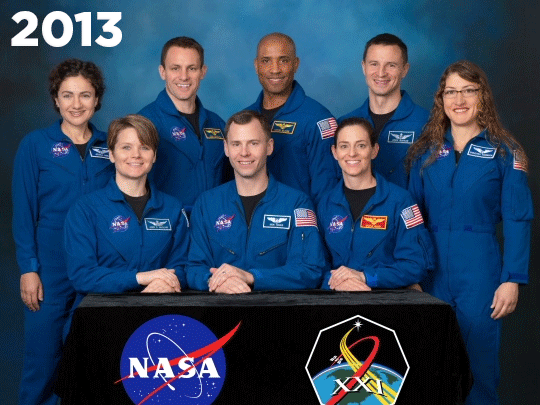
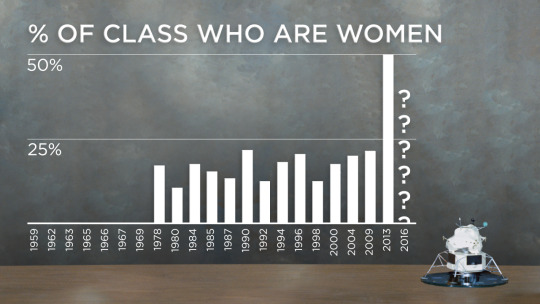
Check out our new video to see every NASA astronaut class. Some patterns emerge.
youtube
12K notes
·
View notes
Text
Space is so creepy and wonderful. Who the hell needs hell when there’s space.
Like there’s an old constellation called Eridanus that you can see in the southern sky, and its not a very interesting constellation. It’s a river. It’s actually the water that’s pouring out of Aquarius, so in the sky it’s kind of boring. It’s a path of stars.
But within Eridanus, in between the stars, there’s a place where the background radiation is unexplainably cold. Because after the Big Bang, there was all this light that scattered everywhere, and it’s the oldest light in the universe, but we can’t see it. It’s so dim that it only shows up as a glow of microwaves, so to us, it just looks like the blackness of the night.
But there’s this spot in Eridanus where that little glow of ancient microwaves isn’t what it should be. It’s cold and dark.
And it’s enormous. Like a billion light year across. Of mostly just emptiness. And we don’t know why. One theory is that it’s simply a huge void, like a place where there are no galaxies. Voids like that do exist. Most of them are smaller, but they’re a sort of predictable part of the structure of the universe. The cold spot in Eridanus, if it were a void, would be so enormous that it would change how we understand the universe.
But another theory is that this cold spot is actually the place where a parallel universe is tangled with our own.
107K notes
·
View notes
Text
Space Gardening 101
You can’t escape eating (or gardening!) your vegetables, even if you’re in space. On Aug. 10, astronauts on the International Space Station sampled their first space grown salad. This freshly harvest red romaine lettuce was grown in the “Veggie” plant growth chamber that is designed to make gardens flourish in weightlessness.
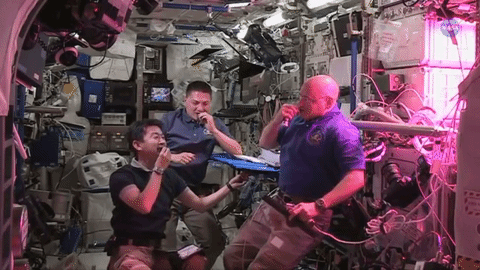
In a weightless environment, there is no up and down, so roots grow in all directions. Water and soil, the materials used to anchor these plants and allow for root growth tend to float away.
How Do We Grow Plants in Space?
1. Plant Pillows

The Veggie chamber helps solve the problems of a weightless environment by using ‘plant pillows’, sounds comfy right? These pillows are bags filled with material for growing plants in space.
2. Wicks

Wicks are implanted into the bags and are used to draw water from inside the pillow to the plant.
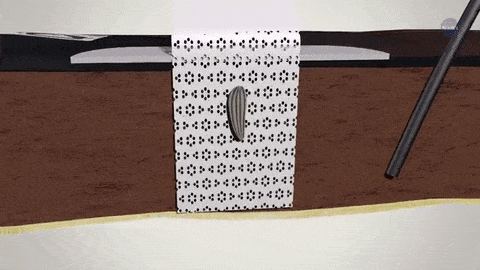
These wicks also provide a place to glue the seeds. It’s important to orient the seeds so roots will grow ‘down’, and shoots that emerge will push out of the bag.
3. LED Lights

LED lights are used for photosynthesis and give the shoots a sense of direction so they keep growing upward. The walls of the Veggie chamber can expand to make room for the plant as it grows.
The purple/pinkish hue surrounding the plants in Veggie is the result of a combination of the red and blue lights, which is what the plants need to grow. Green LEDS were added so the plants look like edible food rather than weird purple plants.
Why are we growing plants in space?
When astronauts travel on deep space missions, like Mars, they will need to be self-sufficient for long periods of time. Having the ability to grow their own food is a big step in that direction. There is also a desire to grow flowering vegetables in space, which is why we are currently tending to zinnia flowers on orbit. Growing these flowering plants will help us understand longer duration growing plants that have to flower in space, such as tomatoes.
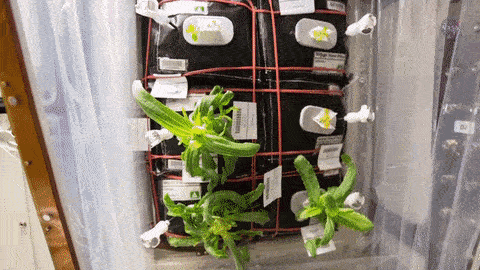
What’s Next? The next SpaceX delivery will include seeds for a small cabbage and additional red romaine lettuce. Upcoming experiments will use various ratios of red and blue lights and different fertilizers in attempts to improve crop yield, nutrition and flavor. The findings from these experiments can be utilized both on Earth and in space.

In addition to the nutrition benefits of growing vegetables in space, the psychological benefits are also significant. Having living plants can help with stress and increase the crews’ enjoyment. It provides the sights, smells and tastes of Earth.
To learn more about gardening in space, watch ScienceCast HERE.
Make sure to follow us on Tumblr for your regular dose of space: http://nasa.tumblr.com
8K notes
·
View notes
Photo









“I would like to humanize the space age by giving a perspective from a non-astronaut, because I think the students will look at that and say, ‘This is an ordinary person. This ordinary person is contributing to history.’”
—Christa McAuliffe (September 2, 1948–January 28, 1986)
5K notes
·
View notes
Quote
For one, cops are up to four times more likely to be abusers themselves than the general population. That’s what you get when you have a macho culture combined with legal authority and a firearm in the house. And the numbers might be even worse than that. It is hard to get exact figures because when a police officer is involved the incident is less likely to be officially recorded. Basically, cops cover for other cops. And while police are let go more than 90 percent of the time for lesser offenses like drug use and theft, 30 percent of officers accused of domestic violence keep their jobs. In other words, they have a better chance of being fired for hitting a bong than for hitting their wife or girlfriend.
4 Groups You Lose Faith In While Working For Charity | Cracked.com (via reesa-chan)
5 notes
·
View notes
Text
How to get into college in 1983: get good grades
How to get into college in 2013: get good grades, speak six languages, be a rocket scientist, and end world hunger
994K notes
·
View notes
Photo

The Women Who Mapped the Universe And Still Couldn’t Get Any Respect
In 1881, Edward Charles Pickering, director of the Harvard Observatory, had a problem: the volume of data coming into his observatory was exceeding his staff’s ability to analyze it. He also had doubts about his staff’s competence–especially that of his assistant, who Pickering dubbed inefficient at cataloging. So he did what any scientist of the latter 19th century would have done: he fired his male assistant and replaced him with his maid, Williamina Fleming. Fleming proved so adept at computing and copying that she would work at Harvard for 34 years–eventually managing a large staff of assistants.
So began an era in Harvard Observatory history where women—more than 80 during Pickering’s tenure, from 1877 to his death in 1919— worked for the director, computing and cataloging data. Some of these women would produce significant work on their own; some would even earn a certain level of fame among followers of female scientists. But the majority are remembered not individually but collectively, by the moniker Pickering’s Harem.
Continue Reading
18K notes
·
View notes
Photo








Is this a glimpse into the future of coastal cities around the world?
Follow @the-future-now
24K notes
·
View notes
Quote
At $10 an hour you’d have to work 1,250 hours to cover the UW’s $12,500 tuition (more, once you take out taxes). In a 12-week summer, that’s more than 100 hours a week.
What really made me feel ancient is that the 1981 UW student guide shows the Med school charged only $1,029 a year back then. Today: $28,040!
Now, I didn’t go to the UW. But I’m going down Husky memory lane because last week The Seattle Times featured a crop of harried UW students looking rueful and broke. The story said skeptical state legislators often say how “they worked their way through college. And then they ask: Why don’t students do that today?”
Of all our delusions, we old farts cling to this bootstrap one the most. We worked our way up on sweat and chicken grease, we say. Can’t this generation? What’s wrong with them?
What’s wrong is that after we got ours, we cut it off for them.
The reason a summer at KFC could pay for a year of UW med school in 1981 isn’t that we were so hardworking and industrious. It’s that taxpayers back then picked up 90 percent of the tab. We weren’t Horatio Algers. We were socialists.
Today, the public picks up only 30 percent of UW tuition, and dropping.
Danny Westneat, “Yes, summer job paid tuition back in ’81, but then we got cheap” (via emonydax)
34K notes
·
View notes
Quote
So much in the solarpunk movement is about the power of every individual to create something bigger through small actions—to cooperate instead of competing. It’s also why it’s so important to keep the movement and genre this way. Solarpunk right now is a collaboration between dozens (if not more) of us, all adding our ideas and conceptions of it, and building. There is no leader, no ultimate reference.
Claudie Arseneault (via sunvaultantho)
121 notes
·
View notes
Text
Artists Covertly Scan Bust of Nefertiti and Release the Data for Free Online
An Iraqi/German pair of artists just pulled off what might be one of the most digitally-enhanced art heists in recent time. They covertly scanned the Nefertiti bust (with an Xbox 360 Kinect sensor, no less) and released the 3D printing plans online. They did so as an act of defiance, as the bust was actually looted from an Egyptian site by German archaeologists.[x]

[article by Claire Voone /Hyperallergic]
Last October, two artists entered the Neues Museum in Berlin, where they clandestinely scanned the bust of Queen Nefertiti, the state museum’s prized gem. Three months later, they released the collected 3D dataset online as a torrent, providing completely free access under public domain to the one object in the museum’s collection off-limits to photographers. Anyone may download and remix the information now; the artists themselves used it to create a 3D-printed, one-to-one polymer resin model they claim is the most precise replica of the bust ever made, with just micrometer variations. That bust now resides permanently in the American University of Cairo as a stand-in for the original, 3,300-year-old work that was removed from its country of origin shortly after its discovery in 1912 by German archaeologists in Amarna.

Nora Al-Badri and Jan Nikolai Nelles with the 3D bust in Cairo
The project, called “The Other Nefertiti,” is the work of German-Iraqi artist Nora Al-Badri and German artist Jan Nikolai Nelles, who consider their actions an artistic intervention to make cultural objects publicly available to all. For years, Germany and Egypt have hotly disputed the rightful location of the stucco-coated, limestone Queen, with Egyptian officials claiming that she left the country illegally and demanding the Neues Museum return her. With this controversy of ownership in mind, Al-Badri and Nelles also want, more broadly, for museums to reassess their collections with a critical eye and consider how they present the narratives of objects from other cultures they own as a result of colonial histories.
The Neues Museum, which the artists believe knows about their project but has chosen not to respond, is particularly guarded towards accessibility to data concerning its collections. According to the pair, although the museum has scanned Nefertiti’s bust, it will not make the information public — a choice that increasingly seems backwards as more and more museums around the world are encouraging the public to access their collections, often through digitization projects. Notably, the British Museum has hosted a “scanathon” where visitors scanned objects on display with their smartphones to crowdsource the creation of a digital archive — an event that contrasts starkly with Al-Badri and Nelles’s covert deed.
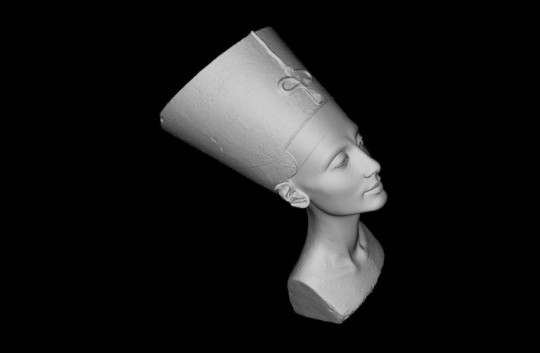
3D rendering of the bust of Nefertiti
“We appeal to [the Neues Museum] and those in charge behind it to rethink their attitude,” Al-Badri told Hyperallergic. “It is very simple to achieve a great outreach by opening their archives to the public domain, where cultural heritage is really accessible for everybody and can’t be possessed.”
In a gesture of clear defiance to institutional order, Al-Badri and Nelles leaked the information at Europe’s largest hacker conference, the annual Chaos Communication Congress. Within 24 hours, at least 1,000 people had already downloaded the torrent from the original seed, and many of them became seeders as well. Since then, the pair has also received requests from Egyptian universities asking to use the information for academic purposes and even businesses wondering if they may use it to create souvenirs. Nefertiti’s bust is one of the most copied works from Ancient Egypt — aside from those with illicit intents, others have used photogrammetry to reconstruct it — and its allure and high-profile presence make it a particularly charged work to engage with in discussions of ownership and institutional representations of artifacts.

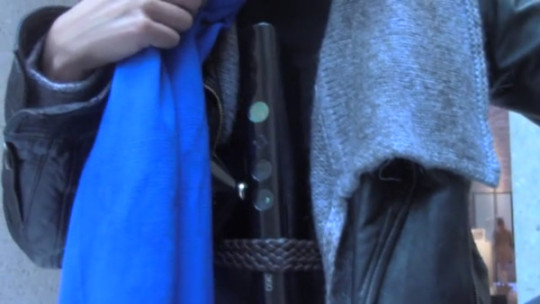
“The head of Nefertiti represents all the other millions of stolen and looted artifacts all over the world currently happening, for example, in Syria, Iraq, and in Egypt,” Al-Badri said. “Archaeological artifacts as a cultural memory originate for the most part from the Global South; however, a vast number of important objects can be found in Western museums and private collections. We should face the fact that the colonial structures continue to exist today and still produce their inherent symbolic struggles.”
Al-Badri and Nelles take issue, for instance, with the Neues Museum’s method of displaying the bust, which apparently does not provide viewers with any context of how it arrived at the museum — thus transforming it and creating a new history tantamount to fiction, they believe. Over the years, the bust has become a symbol of German identity, a status cemented by the fact that the museum is state-run, and many Egyptians have long condemned this shaping of identity with an object from their cultural heritage.
vimeo
The heist: museumshack from jnn on Vimeo
Ultimately, the artists hope their actions will place pressure on not only the Neues Museum but on all museums to repatriate objects to the communities and nations from which they came.
Rather than viewing such an idea as radical, they see it as pragmatic, as a logical update to cultural institutions in the digital era: especially given the technological possibilities of today, the pair believes museums who repatriate artifacts could then show copies or digital representatives of them. Many people have already created their own Nefertitis from the released data; the 3D statue in the American University in Cairo stands as such an example of Al-Badri and Nelles’s ideals for the future of museums, in addition to being one immediate solution that may arise from individual action.
“Luckily there are ways where we don’t even need any topdown effort from institutions or museums,” Al-Badri said, “but where the people can reclaim the museums as their public space through alternative virtual realities, fiction, or captivating the objects like we did.”

3D-printed bust of Nefertiti
[source: Hyperallergic, emphasis mine]
53K notes
·
View notes
Photo



Stem cell bandages
Bandages and band aids containing stem cells to help heal wounds are closer to reality after scientists found a way to keep stem cells alive at room temperature.
By encasing stem cells in a frogspawn-like gel made from a seaweed extract called alginate, scientists at Newcastle University can put them inside bandages, which could be used to help speed up healing from ulcers or burns for example.
The gel retains the cells so that they don’t leave the bandage – it’s the chemicals these cells make that actually do the healing.
The low-cost discovery also has lots of other potential applications, because until now stem cells have had to be kept in specialised conditions; at 37°C, in atmospheric oxygen and 5% carbon dioxide.
Alginate is a natural material extracted from seaweed that is used in cosmetics and food manufacturing and is already used in wound dressings, without stem cells, to keep burns moist.
Read more
Images: Newcastle University
2K notes
·
View notes
Text
“but we NEED good cops”
the idea of the police as a social institution existing to protect communities (or, more nebulously, “make the world a better place”) is a modern fabrication. modern police forces stemmed from the needs of capitalists in europe and northern american states to corral and destroy mass labor movements and the needs of slave-owners in southern american states to intimidate and terrorize local black populations. to allow these labor movements to organize and resist would threaten the all-important profits of their oppressors so they hired private armies to destabilize and harass them.
the first private detective agency in america were the pinkertons and they were employed almost exclusively to infiltrate and destroy unions. the history of modern policing is a history of racist violence. the police are the frontline of the bourgeois in class warfare.
3K notes
·
View notes
Link
Warren says it really well– the Republicans are acting like it’s a huge surprise that the frontrunners in their primary are hyper-extreme jackasses, when it’s really the inevitable result of their policies, rhetoric, and actions.
23 notes
·
View notes
